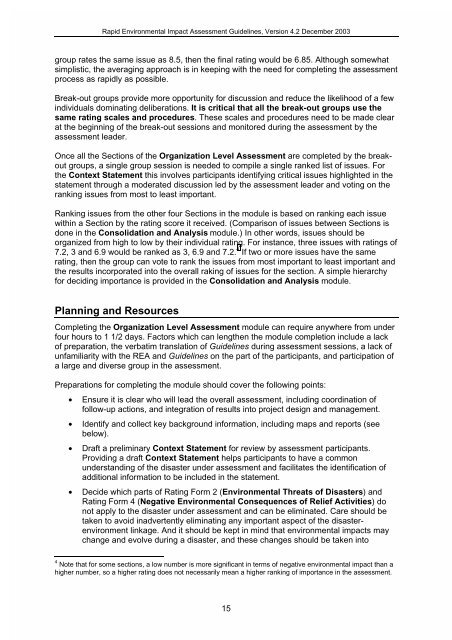Guidelines for Rapid Environmental Impact Assessment in Disasters
Guidelines for Rapid Environmental Impact Assessment in Disasters
Guidelines for Rapid Environmental Impact Assessment in Disasters
You also want an ePaper? Increase the reach of your titles
YUMPU automatically turns print PDFs into web optimized ePapers that Google loves.
<strong>Rapid</strong> <strong>Environmental</strong> <strong>Impact</strong> <strong>Assessment</strong> <strong>Guidel<strong>in</strong>es</strong>, Version 4.2 December 2003<br />
group rates the same issue as 8.5, then the f<strong>in</strong>al rat<strong>in</strong>g would be 6.85. Although somewhat<br />
simplistic, the averag<strong>in</strong>g approach is <strong>in</strong> keep<strong>in</strong>g with the need <strong>for</strong> complet<strong>in</strong>g the assessment<br />
process as rapidly as possible.<br />
Break-out groups provide more opportunity <strong>for</strong> discussion and reduce the likelihood of a few<br />
<strong>in</strong>dividuals dom<strong>in</strong>at<strong>in</strong>g deliberations. It is critical that all the break-out groups use the<br />
same rat<strong>in</strong>g scales and procedures. These scales and procedures need to be made clear<br />
at the beg<strong>in</strong>n<strong>in</strong>g of the break-out sessions and monitored dur<strong>in</strong>g the assessment by the<br />
assessment leader.<br />
Once all the Sections of the Organization Level <strong>Assessment</strong> are completed by the breakout<br />
groups, a s<strong>in</strong>gle group session is needed to compile a s<strong>in</strong>gle ranked list of issues. For<br />
the Context Statement this <strong>in</strong>volves participants identify<strong>in</strong>g critical issues highlighted <strong>in</strong> the<br />
statement through a moderated discussion led by the assessment leader and vot<strong>in</strong>g on the<br />
rank<strong>in</strong>g issues from most to least important.<br />
Rank<strong>in</strong>g issues from the other four Sections <strong>in</strong> the module is based on rank<strong>in</strong>g each issue<br />
with<strong>in</strong> a Section by the rat<strong>in</strong>g score it received. (Comparison of issues between Sections is<br />
done <strong>in</strong> the Consolidation and Analysis module.) In other words, issues should be<br />
organized from high to low by their <strong>in</strong>dividual rat<strong>in</strong>g. For <strong>in</strong>stance, three issues with rat<strong>in</strong>gs of<br />
7.2, 3 and 6.9 would be ranked as 3, 6.9 and 7.2. 4 If two or more issues have the same<br />
rat<strong>in</strong>g, then the group can vote to rank the issues from most important to least important and<br />
the results <strong>in</strong>corporated <strong>in</strong>to the overall rak<strong>in</strong>g of issues <strong>for</strong> the section. A simple hierarchy<br />
<strong>for</strong> decid<strong>in</strong>g importance is provided <strong>in</strong> the Consolidation and Analysis module.<br />
Plann<strong>in</strong>g and Resources<br />
Complet<strong>in</strong>g the Organization Level <strong>Assessment</strong> module can require anywhere from under<br />
four hours to 1 1/2 days. Factors which can lengthen the module completion <strong>in</strong>clude a lack<br />
of preparation, the verbatim translation of <strong>Guidel<strong>in</strong>es</strong> dur<strong>in</strong>g assessment sessions, a lack of<br />
unfamiliarity with the REA and <strong>Guidel<strong>in</strong>es</strong> on the part of the participants, and participation of<br />
a large and diverse group <strong>in</strong> the assessment.<br />
Preparations <strong>for</strong> complet<strong>in</strong>g the module should cover the follow<strong>in</strong>g po<strong>in</strong>ts:<br />
• Ensure it is clear who will lead the overall assessment, <strong>in</strong>clud<strong>in</strong>g coord<strong>in</strong>ation of<br />
follow-up actions, and <strong>in</strong>tegration of results <strong>in</strong>to project design and management.<br />
• Identify and collect key background <strong>in</strong><strong>for</strong>mation, <strong>in</strong>clud<strong>in</strong>g maps and reports (see<br />
below).<br />
• Draft a prelim<strong>in</strong>ary Context Statement <strong>for</strong> review by assessment participants.<br />
Provid<strong>in</strong>g a draft Context Statement helps participants to have a common<br />
understand<strong>in</strong>g of the disaster under assessment and facilitates the identification of<br />
additional <strong>in</strong><strong>for</strong>mation to be <strong>in</strong>cluded <strong>in</strong> the statement.<br />
• Decide which parts of Rat<strong>in</strong>g Form 2 (<strong>Environmental</strong> Threats of <strong>Disasters</strong>) and<br />
Rat<strong>in</strong>g Form 4 (Negative <strong>Environmental</strong> Consequences of Relief Activities) do<br />
not apply to the disaster under assessment and can be elim<strong>in</strong>ated. Care should be<br />
taken to avoid <strong>in</strong>advertently elim<strong>in</strong>at<strong>in</strong>g any important aspect of the disasterenvironment<br />
l<strong>in</strong>kage. And it should be kept <strong>in</strong> m<strong>in</strong>d that environmental impacts may<br />
change and evolve dur<strong>in</strong>g a disaster, and these changes should be taken <strong>in</strong>to<br />
4 Note that <strong>for</strong> some sections, a low number is more significant <strong>in</strong> terms of negative environmental impact than a<br />
higher number, so a higher rat<strong>in</strong>g does not necessarily mean a higher rank<strong>in</strong>g of importance <strong>in</strong> the assessment.<br />
15
















